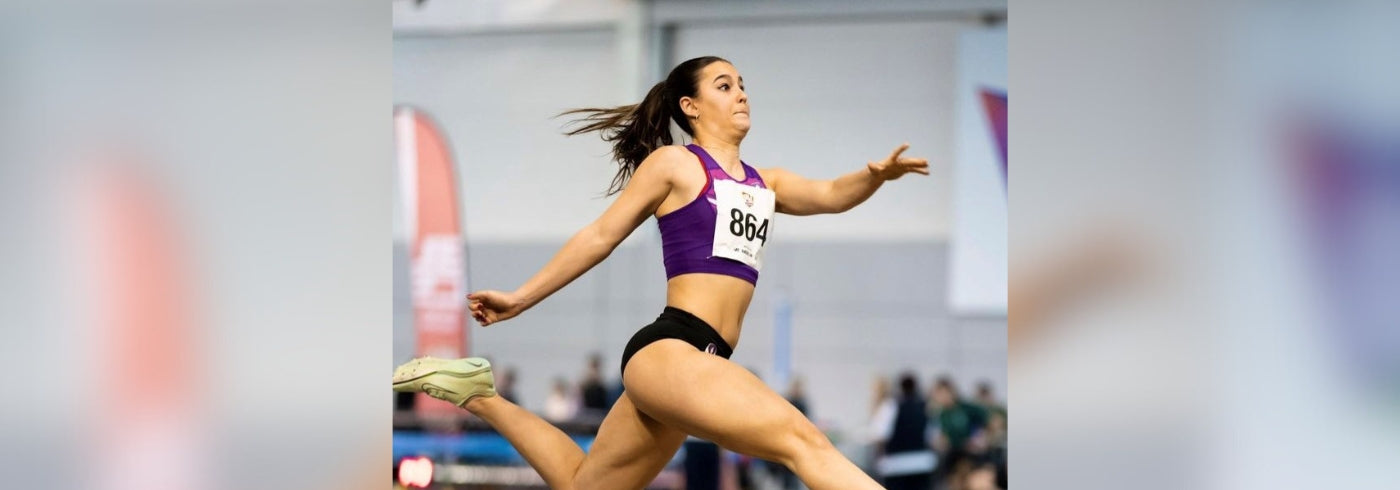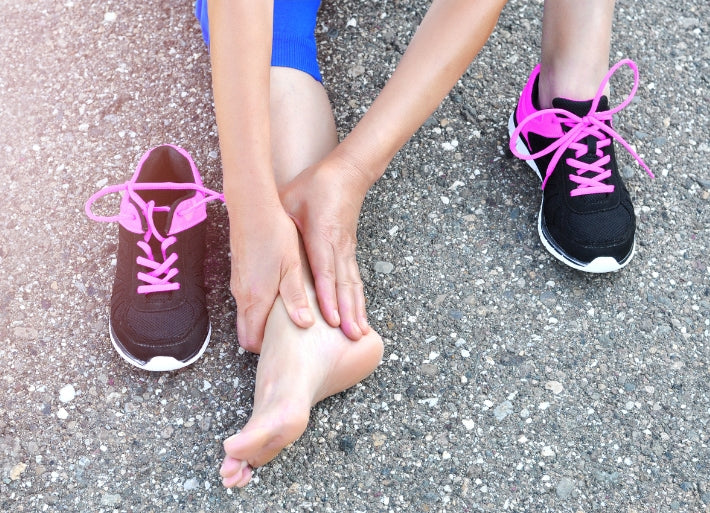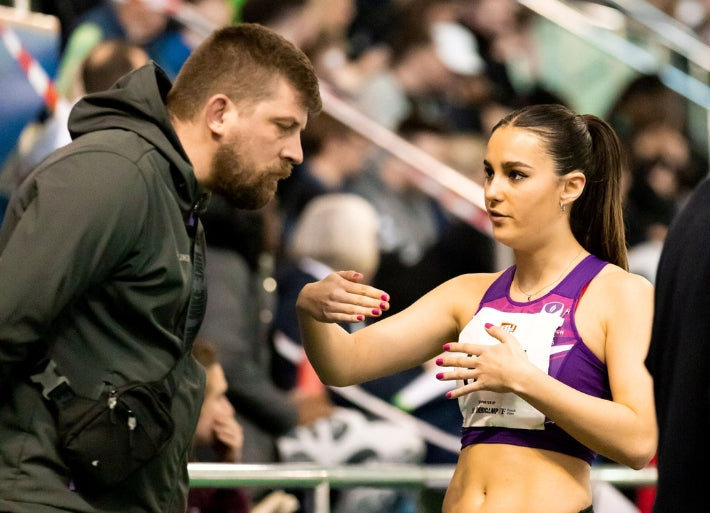
Competing After Injury in Athletics
BY RUBY JERGES
After rupturing my ATFL ligament in my take-off foot last March, I have finally returned to competition following a long ten months of rehab and training. It has been quite a while since I last wrote an article for the athletics community, and in that time, I certainly faced an eclectic mix of challenges. However, I've also learnt a lot from these experiences.
At the start of January, I opened my indoor season in a small local competition. I have been very lucky to have great support around me because since then, I progressed to compete in a few more competitions I hadn't expected to necessarily qualify for. After completing my indoor season, I have been through the transition of coming back to competition post-injury, progressing skills such as goal management and dealing with disappointment.
In this article, I will reflect on my experiences relating to the points I've mentioned above and hopefully provide some insight and guidance for athletes in similar situations!

Dealing with disappointment
On reflection, one aspect of returning to competition post-injury that I think I was particularly underprepared for was dealing with disappointment.
This isn't as black and white as “I didn't jump as far as I wanted”. There are other dimensions to disappointment where you may compare your current fitness and ability to what it was before, for example.
Despite these disappointments being detrimental to confidence, they are all normal ways to feel, so don't shut yourself off from those around you in the process.

Be open with others
Instead, I found it beneficial to use the opportunity to have conversations which addressed how I felt. While you may not be able to solve everything, you probably won't be the only one feeling the way you do, and getting frustration off your chest while addressing how you feel is a very healthy thing to do.
So, be prepared for disappointment and frustration. If you set high targets and goals (just like I do), you must be prepared to sometimes not hit them. I have found that an effective way to do this is to celebrate the small wins.
Process versus outcome is key to the above, which I will talk more about later on...

Embracing your injuries
Even though I was doing more training to compensate for time missed from injury, I learnt that you rarely return as the same athlete that you once were.
Whilst I initially thought this would be a negative thing, I subsequently noticed that even though I lost elements of technique execution, my strength (which had been a central focus in rehab) had since become even stronger than before. This was a positive outcome of injury, and it's important to see these little plus points to offset the negativity.
I also found that as I began my rehab, it flagged up some issues with my ankle balance and strength. However, what surprised me was that these issues weren't only in my affected foot, but they were also apparent in my non-affected foot. During my rehab, I discovered that naturally, my ankle mobility and strength were relatively poor even before I was injured – and this may even have contributed to the severity of the injury.
Upon discovering this, it meant we could tailor rehab exercises to effectively repair my affected foot while also increasing my general ankle strength and mobility to reduce the chances of ankle-related issues occurring again in either foot.
Many assume changes from injury to be negative. However, as I reflected on above, these changes often come with some positives! When injured, it's easy to have tunnel vision and think towards getting out to the other side of the injury, and that is fine. However, I would recommend looking more broadly and embracing what you may learn about yourself, physically or mentally, along the way. You never know where this may come in handy in the future!

Ruby Jerges & Lukasz Zawila (Sakura Sports Media)
Expectations and goal setting
As I've briefly discussed in previous articles, I have always found goal-setting valuable in helping me decide what I want to get out of training and what I hope to achieve in competitions, which is just as important when returning from injury. I try to break down my goal setting by using the SMART acronym (which I will discuss soon), as well as embracing the difference between process and outcome goals.
Process vs. outcome goals when returning from injury
Firstly, I want to reintroduce process and outcome goals as valuable tools for managing your targets.
Process goals (also known as performance goals) break down the details of your actual technical performance.
An example of a process goal for a long jumper may be to hold your leg and shoot on landing to reach further. When it comes to outcome goals for a long jumper, this could be to qualify for your age group nationals and land in the top 8. I also found that when coming back to competition, it was beneficial to focus more on my performance goals. If I'm being honest, I had a very vague idea of where I would be regarding the distances I would jump and the outcomes I could accomplish.
On the other hand, outcome goals look more at the outcome of results, whether that’s the distance which has been jumped, time achieved or your overall position.

Which goals should you focus on?
From my experience, thinking more about the process of my competition rather than its outcome eliminated external pressures of what I may have thought were expected of me. Instead, it creates an opportunity to think about how my rehab and strength work could come together to improve different components of my jumping.
Whilst you can argue that process goals are usually a better aspect to focus on when returning from injury, I believe you shouldn't entirely disregard outcome goals. Ultimately, even though it may be unrealistic to expect to attain every goal immediately when returning from injury, it is always good to have your outcome goals in focus.
Reminding yourself of outcome goals before competition can ultimately help maintain motivation and keep you on track to where you want to be eventually.

SMART goal setting
Extending your goal setting to the SMART acronym enables you to reassess your goals regularly and recognise your progress, helping to acknowledge where there may be gaps in your fitness or technique.
As a reminder, SMART goals are broken down by the following...
- Specific
- Measurable
- Achievable
- Realistic
- Time-bound
Setting a SMART goal enabled me to maintain a constructive perspective by acknowledging the time frame I had in which to work on this target. This acted as a reminder that after my first competition back, I had many more ahead of me, so just being in a position to compete was already a goal achieved.
Additionally, implementing SMART goals helps recognise the specific technical details that may or may not have been achieved, consequently reminding me of what needs to remain in focus moving forward.
Ensuring the goal is realistic means that if you don't achieve it the first time, it isn't so unrealistic that it discourages you from going forward.
Instead, the goal fires you to achieve marginal improvements which eventually should come together and result in greater success and confidence.

Goal setting takeaways
Translating what I have learnt from goal setting into advice, I certainly believe less is more in the early stages of competition post-injury. By overdoing it, you risk putting yourself under too much pressure and becoming overly fixated, which isn't necessarily valuable straight away.
Goal setting gives you perspective as it directs the focus to just yourself. Even when my goals weren't instantly achievable, I learnt to see this as exciting rather than frustrating.
Remember, your goals aren't always set in stone. You can change them and in many cases, you should reassess and adapt them. Everyone is different, so it should be what works for you!

Trust the process
From my experience, as I returned to competition post-injury, I have learnt a lot about the importance of patience.
Although I am back competing, I still feel like I have more to work on until I can bring everything together to jump how I know I can. I sometimes feel disheartened as I think I haven't done all I want to do in athletics. However, since my injury, I have learnt to look at that more positively and appreciate that I have a lot more ahead of me rather than not enough behind me.
Everyone peaks at different times, and everyone faces different setbacks. The way you come back from it is down to you. Remember that as an athlete, whatever your sport, a lot is out of your control. Injury is one strand of that – but even in injury, there will always be some things that can be controlled, big or small.
When you look at the bigger picture, it's effectively managing your goals, expectations, and training that will always get you one step closer to being back on track to where you want to go.
About Ruby Jerges

Ruby is primarily a long jumper, but is also known as a sprinter!
She started doing gymnastics for a little while at just five years old, but then realised in secondary school that athletics was what she wanted to pursue.
Ruby loves to inspire young girls in getting involved with athletics, which she is keen to do through her blogs for us here at Neuff!
She competes for Crawley AC, as well as for Loughborough University.
Instagram: @ruby.jerges


Leave a comment